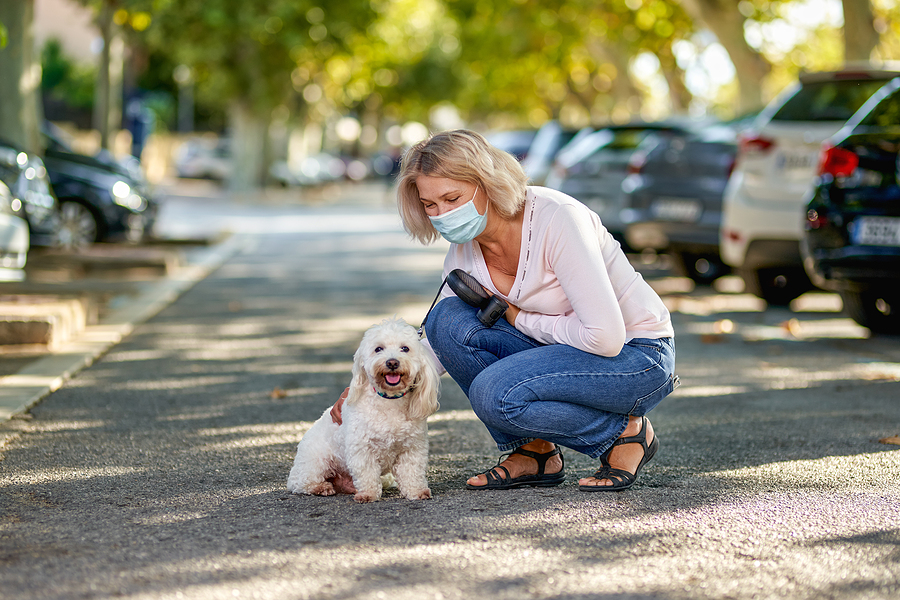At the start of the pandemic, concern was sometimes expressed that dogs would be disturbed because people were now wearing face masks. Personally, I was skeptical, from the evidence of my own highly reactive Pug. She’s attentive to small details – one thing she’ll always object to is a person who is looking at their phone. Nevertheless, she has never shown any sign of being bothered by face masks.
In fact, there doesn’t seem to be much evidence that mask-wearing has resulted in a new epidemic of dog reactivity. But we know that dogs can react to human attire – that’s why in puppy classes we make sure to expose them to things like funny hats. So why the lack of reaction to this accessory that to us, as humans, seems quite novel?
Fear Free certified trainer Kate LaSala agrees that she has not seen cases of previously non-reactive dogs reacting to masks and observes that there’s a lesson here about exactly what puppy socialization is meant to do.
“The goal of socialization is to teach the dog that novelty is safe,” she says. “It’s impossible to expose a puppy to every single thing they’re going to encounter in the course of their life. So we focus on teaching puppies that new things are safe, so even if they’re not exposed to something like a person wearing a mask in the socialization window, it just kind of rolls off them: ‘Okay, that’s weird but whatever.'”
So she’s not surprised that while some of her clients with dogs who are already fearful of strangers report their dogs are even more fearful of strangers in masks, there haven’t been any who were fine before and are now barking at masked people. She also notes that even with reactive dogs who have this problem, we may not observe it on the street, because the owners know their dogs: “If you do have a dog who’s sensitive to unusual-looking people, those owners are probably prepared to handle that,” she says.
LaSala does think masks may make our verbal cues more difficult for dogs to hear, especially in a noisy urban environment. “I have been advising people to brush up on hand signals,” she says. “If you’re out on the street and you need the dog to sit and the dog can’t make out that verbal cue, having that hand signal can be helpful.”
While training usually begins with a hand signal, many people fade them out and never use them again. But it’s good to keep them in your dog’s repertoire. There’s some evidence that hand signals are more significant for them than verbal cues. And you may need them later: when my first Pug went deaf when she was older, I was glad I still had a familiar way of communicating with her.
In general, though, our covered mouths may impair our dog’s understanding less than we language-obsessed humans may realize. “Dogs are really good at reading hard and soft eyes,” LaSala says. “You still have eye contact, and you can be expressive with your eyes. Make sure you’re smiling under your mask and that’s coming through with your eyes.”
There’s some science that shows that dogs are particularly attentive to our eyes. Sarah-Elizabeth Byosiere, Ph. D., director of the Thinking Dog Center at Hunter College, points to one study of dog’s processing of human facial expressions that used an eye tracker device. It allowed researchers to know exactly where the dog was looking and found that dogs looked most often at a person’s eyes. “This highlights that even when your face is not covered, that potentially dogs are predominantly looking at the eyes,” she says.
She also notes that some studies show that dogs can follow a human gaze. Even without moving your head in the direction you’re looking, but just using your eyes, dogs understand where you’re looking, in much the same way they’ve been shown to understand pointing.
What’s more, Dr. Byosiere says, another sense entirely is often more important to dogs: smell. “Dogs may not always rely as much on their sense of vision as on smell,” she says. “Whether someone is familiar or unfamiliar may be something they can ascertain via the nose.”
On the whole though, one reason dogs have learned to live in our crazy human world is that they’re so adaptable.
“I generally think dogs are really resilient,” says LaSala. And Byosiere, who works with dogs in New York City, says, “They’re so robust, and I think it’s because they have to be. There are so many sights, there are so many smells, there’s literally always something happening around them. A dog that’s a successful and comfortable dog in an urban environment is one that really can compensate and adjust to all these uncertainties.”
This article was reviewed/edited by board-certified veterinary behaviorist Dr. Kenneth Martin and/or veterinary technician specialist in behavior Debbie Martin, LVT.
Linda Lombardi writes about the animals that share our planet and our homes for magazines including The Bark, websites including National Geographic and Mongabay.com, and for the Associated Press. Her most recent book, co-authored with Deirdre Franklin, is The Pit Bull Life: A Dog Lover’s Companion.








